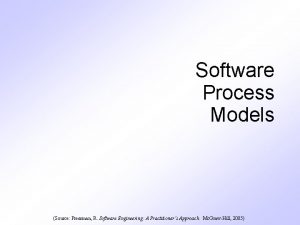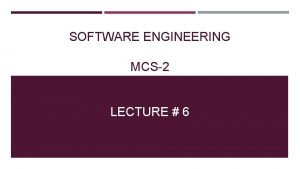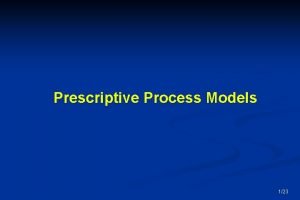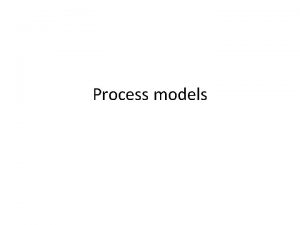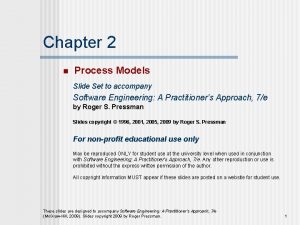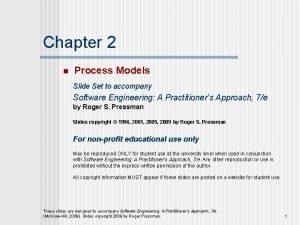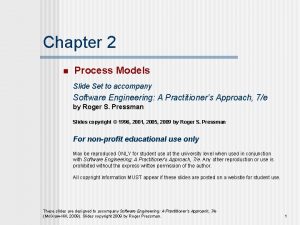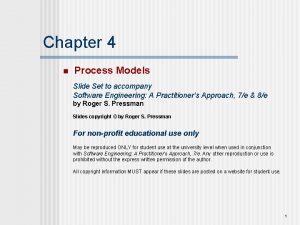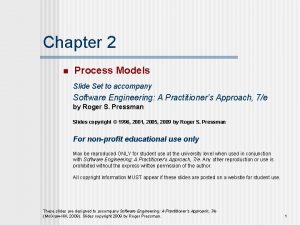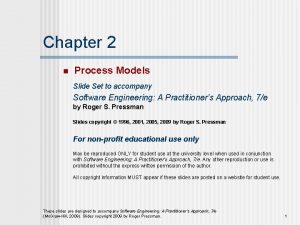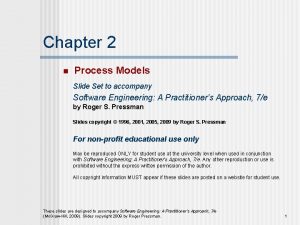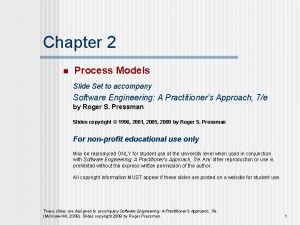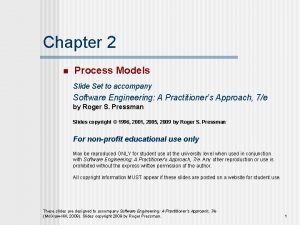Chapter 4 n Process Models Slide Set to














- Slides: 14

Chapter 4 n Process Models Slide Set to accompany Software Engineering: A Practitioner’s Approach, 8/e by Roger S. Pressman and Bruce R. Maxim Slides copyright © 1996, 2001, 2005, 2009, 2014 by Roger S. Pressman For non-profit educational use only May be reproduced ONLY for student use at the university level when used in conjunction with Software Engineering: A Practitioner's Approach, 8/e. Any other reproduction or use is prohibited without the express written permission of the author. All copyright information MUST appear if these slides are posted on a website for student use. These slides are designed to accompany Software Engineering: A Practitioner’s Approach, 8/e (Mc. Graw-Hill, 2014). Slides copyright 2014 by Roger Pressman. 1

Prescriptive Models Prescriptive process models advocate an orderly approach to software engineering That leads to a few questions … n If prescriptive process models strive for structure and order, are they inappropriate for a software world that thrives on change? n Yet, if we reject traditional process models (and the order they imply) and replace them with something less structured, do we make it impossible to achieve coordination and coherence in software work? n These slides are designed to accompany Software Engineering: A Practitioner’s Approach, 8/e (Mc. Graw-Hill, 2014). Slides copyright 2014 by Roger Pressman. 2

The Waterfall Model These slides are designed to accompany Software Engineering: A Practitioner’s Approach, 8/e (Mc. Graw-Hill, 2014). Slides copyright 2014 by Roger Pressman. 3

The V-Model These slides are designed to accompany Software Engineering: A Practitioner’s Approach, 8/e (Mc. Graw-Hill, 2014). Slides copyright 2014 by Roger Pressman. 4

The Incremental Model These slides are designed to accompany Software Engineering: A Practitioner’s Approach, 8/e (Mc. Graw-Hill, 2014). Slides copyright 2014 by Roger Pressman. 5

Evolutionary Models: Prototyping Quick plan communication Modeling Quick design Deployment delivery & feedback Construction of prototype These slides are designed to accompany Software Engineering: A Practitioner’s Approach, 8/e (Mc. Graw-Hill, 2014). Slides copyright 2014 by Roger Pressman. 6

Evolutionary Models: The Spiral These slides are designed to accompany Software Engineering: A Practitioner’s Approach, 8/e (Mc. Graw-Hill, 2014). Slides copyright 2014 by Roger Pressman. 7

Evolutionary Models: Concurrent These slides are designed to accompany Software Engineering: A Practitioner’s Approach, 8/e (Mc. Graw-Hill, 2014). Slides copyright 2014 by Roger Pressman. 8

Still Other Process Models n n Component based development—the process to apply when reuse is a development objective Formal methods—emphasizes the mathematical specification of requirements AOSD—provides a process and methodological approach for defining, specifying, designing, and constructing aspects Unified Process—a “use-case driven, architecturecentric, iterative and incremental” software process closely aligned with the Unified Modeling Language (UML) These slides are designed to accompany Software Engineering: A Practitioner’s Approach, 8/e (Mc. Graw-Hill, 2014). Slides copyright 2014 by Roger Pressman. 9

The Unified Process (UP) elaboration inception These slides are designed to accompany Software Engineering: A Practitioner’s Approach, 8/e (Mc. Graw-Hill, 2014). Slides copyright 2014 by Roger Pressman. 10

UP Phases These slides are designed to accompany Software Engineering: A Practitioner’s Approach, 8/e (Mc. Graw-Hill, 2014). Slides copyright 2014 by Roger Pressman. 11

UP Work Products These slides are designed to accompany Software Engineering: A Practitioner’s Approach, 8/e (Mc. Graw-Hill, 2014). Slides copyright 2014 by Roger Pressman. 12

Personal Software Process (PSP) n n n Planning. This activity isolates requirements and develops both size and resource estimates. In addition, a defect estimate (the number of defects projected for the work) is made. All metrics are recorded on worksheets or templates. Finally, development tasks are identified and a project schedule is created. High-level design. An external specification is created for each component and a component design is created. Prototypes are built when uncertainty exists. All issues are recorded and tracked. High-level design review. Formal verification methods (Chapter 21) are applied to uncover errors in the design. Metrics are maintained for all important tasks and work results. Development. The component level design is refined and reviewed. Code is generated, reviewed, compiled, and tested. Metrics are maintained for all important tasks and work results. Postmortem. Using measures and metrics collected the effectiveness of the process is determined. If this is a large amount of data it should be analyzed statistically), Measures and metrics should provide guidance for modifying the process to improve its effectiveness. These slides are designed to accompany Software Engineering: A Practitioner’s Approach, 8/e (Mc. Graw-Hill, 2014). Slides copyright 2014 by Roger Pressman. 13

Team Software Process (TSP) n n n Build self-directed teams that plan and track their work, establish goals, and own their processes and plans. These can be pure software teams or integrated product teams (IPT) of three to about 20 engineers. Show managers how to coach and motivate their teams and how to help them sustain peak performance. Accelerate software process improvement by making CMM Level 5 behavior normal and expected. n n n The Capability Maturity Model (CMM), a measure of the effectiveness of a software process, is discussed in Chapter 30. Provide improvement guidance to high-maturity organizations. Facilitate university teaching of industrial-grade team skills. These slides are designed to accompany Software Engineering: A Practitioner’s Approach, 8/e (Mc. Graw-Hill, 2014). Slides copyright 2014 by Roger Pressman. 14
 Heel toe heel toe slide slide slide
Heel toe heel toe slide slide slide Total set awareness set consideration set
Total set awareness set consideration set Training set validation set test set
Training set validation set test set What is modals and semi modals
What is modals and semi modals Binomials factoring
Binomials factoring Bounded set vs centered set
Bounded set vs centered set Crisp set vs fuzzy set
Crisp set vs fuzzy set Crisp set vs fuzzy set
Crisp set vs fuzzy set Crisp set vs fuzzy set
Crisp set vs fuzzy set What is the overlap of data set 1 and data set 2?
What is the overlap of data set 1 and data set 2? The function from set a to set b is
The function from set a to set b is What is software process model
What is software process model Evolutionary software process models
Evolutionary software process models Software maintenance in software engineering ppt
Software maintenance in software engineering ppt Prescriptive process models
Prescriptive process models











